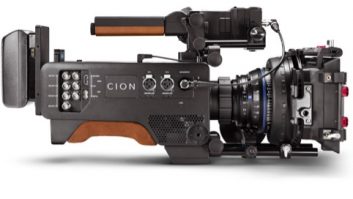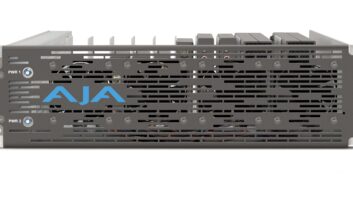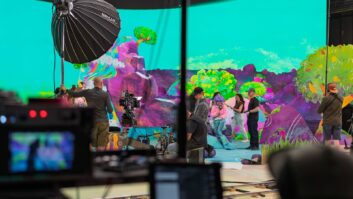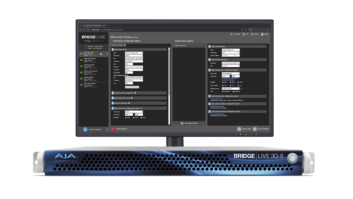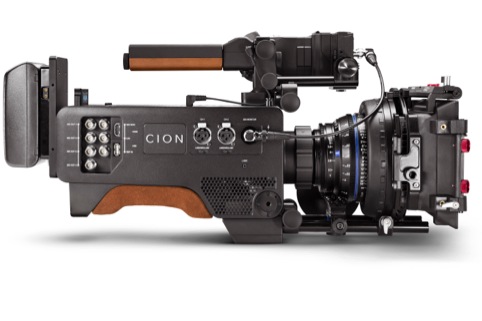
Four years of concept and two years of “solid physical work” has resulted in Cion, AJA’s first camera and the unexpected product launch of NAB.
Just as Blackmagic Design wowed visitors in 2012 with its 2K Cinema Camera, the capture card and data recorder vendor pulled a rabbit out of the hat with this 4K imager which is destined to hit shelves in late summer.
It’s not likely to be the only one in the range either. Expect further cameras from AJA at next year’s event.
“Cion is an amalgamation of all the IP and knowledge we’ve gained creating converters, desktop capture cards and tapeless video recorders like the Ki Pro products over a number of years. It just made sense,” said Bryce Button, product manager.
“In terms of non-traditional hardware companies moving into cameras, [Blackmagic] indicated that we could be successful,” he admitted.
Another motivation was a gap in the market for an inexpensive, high quality imager that felt more like a conventional production camera, less like a DSLR. The same pragmatic argument that led Blackmagic to devise the Ursa.
“We’ve worked closely with camera manufacturers for years, but one thing that definitely made us pay attention was watching DSLR workflows where users were taking the small form factor but building up an array of accessories and rigs around it to make it a useable production camera,” said Button. “By the time you’ve finished, it costs many times more. That didn’t make a lot of sense to us.”
“We’ve also played to our strengths. We’ve been encoding ProRes in hardware since 2007 and offer support for the full range of Apple ProRes codecs including ProRes 4444.”
Even Sony has included ProRes in the F55, underlining the direction AJA has been pushing toward.
“There will be some final tweaks prior to shipment to make sure we have the best looking image out of the sensor we can obtain. By creating Apple ProRes files, creatives can achieve the richness and depth they desire without having to strain storage requirements. That’s the pragmatic marriage you can achieve with Cion.”
Button also pointed out that AJA has been working in 4K for several years, with desktop, conversion and recorder products.
Cion ships with a PL lens mount, which is removable allowing third parties to offer a variety of lens mounts for the camera.
In-camera ProRes recording up to 4K 60fps is possible using AJA Pak SSD media.
AJA’s Raw 4K data is not recorded internally to Pak drives, but instead is transmitted over either 3G-SDI up to 4K at 120fps or up to 4K at 30fps across Thunderbolt (marking one of the first implementations of Thunderbolt as a medium for carrying Raw data).
“Having a quality CMOS sensor is just the beginning,” said Button. “The real work lies in the colour science behind it.”
It features 12 stops of dynamic range, a global shutter and a filter system combining IR cut and optical low pass filters to reduce moire and produce accurate colours.
Cion’s ergonomics should also find favour with a wide range of users who need to shoulder a camera, whether they produce documentaries, reality programmes, sports or dramatic/narrative when handheld camera operation is a consideration, reckons Button.
“High-end feature films are probably best served by digital cameras like the Sony F65 but then these cost 10 times as much,” he said. “For the majority of work, from indie films to drama, docs and corporate we are trying to design a camera that doesn’t cost a fortune with all the workflow needs and quality people are looking for.”
AJA intends to keep the AJA Raw spec open and accessible, providing the information about the format to enable support for it in a variety of post and edit applications.
Since AJA has already monetised the R&D for ProRes encoding it does not have to pass this cost on and is one reason for Cion low £4500 price tag. To create a complete camera system, end users will only need to add the battery, lens and electronic viewfinder of their choice.
AJA is establishing a new rental and sales channel for the unit.
“If you look at existing 4K cameras, I think there is a consensus that with the F55, for example, you might achieve more definition and with the Canon C500, for example, the colour science might be softer and more film like. We’re hoping to meet the middle ground.”
Indeed the price point seems to fit Cion between very low cost solutions like DSLRs and the Blackmagic Cinema 4K and Ursa cameras and cameras like the F5.
“It will have its own look,” maintains fellow AJA representative Andy Bellamy. “People will say ‘I’m going to get the Cion’ in a way that Red has a look or ARRI has a look. We will have a look.”
